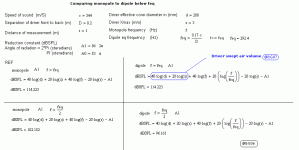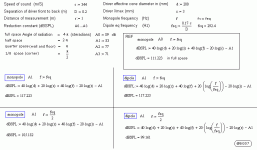Hello,
I have examined this web page;
http://www.angelfire.com/comics/illustartions/
There you can find a relation between the air volume and SPL. Can somebody please explain me how it is possible to calculate the needed air volume which needs to be moved in order to achieve certain SPL value?
Thanks in advance
Onur
I have examined this web page;
http://www.angelfire.com/comics/illustartions/
There you can find a relation between the air volume and SPL. Can somebody please explain me how it is possible to calculate the needed air volume which needs to be moved in order to achieve certain SPL value?
Thanks in advance
Onur
It is depended on the frequency and the volume of the space in which the sound is generated, am I right? Without knowing the volume of the space in which the pressure wave is generated, how could he came up with such results?
However, if there is a way to calculate the needed air volume which needs to be moved for open baffle speakers for a specific frequency, I would like to examine that. Can somebody forwar a link?
/Onur
However, if there is a way to calculate the needed air volume which needs to be moved for open baffle speakers for a specific frequency, I would like to examine that. Can somebody forwar a link?
/Onur
Check this out:
http://www.linkwitzlab.com/models.htm#A1
Scroll down, there is an explanation as to how the displacement is related with frequency and some theory.
http://www.linkwitzlab.com/models.htm#A1
Scroll down, there is an explanation as to how the displacement is related with frequency and some theory.
More odd shortcomings:
Look again at the table for 112 dB where 100 cu in equates 645.16 cu cm, that is 1 cu in= 6.45 cu cm and obvious wrong as 1 cu in = 2.54^3 and about 16.4 cm^3, then all the tables are systematically erroneous.
But worse is this assumption:
‘…For a totally open-baffle ELF design, the roll-off rate will be 18dB/octave (room gain not taken into account). For an aperiodic design such as the one I'm proposing, it will be much closer to 12dB/octave…’
...as the SPL losses, when loading aperiodic from 18 dB to 12 dB/octave is not included.
b
Look again at the table for 112 dB where 100 cu in equates 645.16 cu cm, that is 1 cu in= 6.45 cu cm and obvious wrong as 1 cu in = 2.54^3 and about 16.4 cm^3, then all the tables are systematically erroneous.
But worse is this assumption:
‘…For a totally open-baffle ELF design, the roll-off rate will be 18dB/octave (room gain not taken into account). For an aperiodic design such as the one I'm proposing, it will be much closer to 12dB/octave…’
...as the SPL losses, when loading aperiodic from 18 dB to 12 dB/octave is not included.
b
Hi,
The maximum levels a sealed box driver can produce at low frequencies
assuming it has enough juice to get it to excursion limits is solely
determined by the Vd (volume displacement of the driver) Sd x exc.
Maximum levels obviously drop with frequency, the actual levels are
fairly arbitary, usually they are calculated at 1m into half space.
Reflex loading makes a big positive difference. Open baffle loading
makes an ever increasing negative difference, combined with the
reducing levels available as you go lower it becomes obvious open
baffles (of reasonable size) cannot do low bass at decent levels.
Try WinISDbeta for illustrations of excursion and related max levels.
🙂sreten.
The maximum levels a sealed box driver can produce at low frequencies
assuming it has enough juice to get it to excursion limits is solely
determined by the Vd (volume displacement of the driver) Sd x exc.
Maximum levels obviously drop with frequency, the actual levels are
fairly arbitary, usually they are calculated at 1m into half space.
Reflex loading makes a big positive difference. Open baffle loading
makes an ever increasing negative difference, combined with the
reducing levels available as you go lower it becomes obvious open
baffles (of reasonable size) cannot do low bass at decent levels.
Try WinISDbeta for illustrations of excursion and related max levels.
🙂sreten.
Some hints, wouldn't want to just give you the answer and spoil the "discovery" for you.
Relation of volume velocity to SPL is perhaps the proper question.
All over the 'net there are equations relating excursion with SPL, and volume velocity (U-m^3/s) is just excursion * Sd * frequency.
In reality SPL is directly proportional to piston acceleration, not velocity.
think of sinusoidal motion.
Excursion:
X(t)=X0*sin(wt)
Velocity = dX/dt:
V(t)=w*X0*cos(wt)
Acceleration = dV/dt:
A(t)=-w^2*X0*sin(wt)
Relation of volume velocity to SPL is perhaps the proper question.
All over the 'net there are equations relating excursion with SPL, and volume velocity (U-m^3/s) is just excursion * Sd * frequency.
In reality SPL is directly proportional to piston acceleration, not velocity.
think of sinusoidal motion.
Excursion:
X(t)=X0*sin(wt)
Velocity = dX/dt:
V(t)=w*X0*cos(wt)
Acceleration = dV/dt:
A(t)=-w^2*X0*sin(wt)
During my search for inline passive (before amp.) crossovers I found myself reading this article :
http://sound.westhost.com/qb5align.htm
It would be more scientific to know how the kp (the power output constant) is calculated. Any ideas?
http://sound.westhost.com/qb5align.htm
It would be more scientific to know how the kp (the power output constant) is calculated. Any ideas?
….It would be more scientific to know how the kp (the power output constant) is calculated. Any ideas?…
Do you need a scientifically secured explanation of kp and more advanced than the attempts given by Robert C White / Rod Elliott at the same main URL you just visited?
5 Calculating kp: http://sound.westhost.com/articles/cscaling.htm#s5
Comments of all the answers you’ve got so far: Good enough?
b
Onur said:There you can find a relation between the air volume and SPL. Can somebody please explain me how it is possible to calculate the needed air volume which needs to be moved in order to achieve certain SPL value?
Yes.
Assuming radiation in free space and no directionality, the equation for the sound pressure from a point source can be used:
p=jwQ*rho0/(4*pi*r)
where
w is the angular frequency in rad/s,
Q is the volume flow in m³/s,
rho0 is 1.2 kg/m³,
r is the distance in metres.
The volume flow Q is the derivative of volume, Q=jwV, and volume is displacement*surface V=x*Sd.
All in all this results in
p=-w²*x*Sd*rho0/(4*pi*r)
if x represents the peak value of the displacement, so does p. If it is the RMS value of the displacement, the pressure will also be RMS, and possible to convert to sound pressure level, SPL, in dB by the equation Lp=20*log(|p|/pref), where pref is 20 µPa.
For half space, the SPL becomes 6 dB higher.
Hi,
I hereby recall my earlier posted(#6) picture containing some derived SPL equations: ‘dipole-feq.gif’ as the picture partly contains errors and assumptions not valid thus should not be consulted and is replaced with the submitted ‘dipole-feq- rev.gif’. Sorry for this inconvenience.
b
1(1)
I hereby recall my earlier posted(#6) picture containing some derived SPL equations: ‘dipole-feq.gif’ as the picture partly contains errors and assumptions not valid thus should not be consulted and is replaced with the submitted ‘dipole-feq- rev.gif’. Sorry for this inconvenience.
b
1(1)
Attachments
Comments of all the answers you’ve got so far: Good enough?
Indeed, I sometimes have the difficulty in expressing the problem in engineering terms, therefore I just can not figure out what to type in a search engine to find the answer (ie. I wouldn't look for kp under "Compliance Scaling and Other Techniques") Not because I am lazy, just because I couldn't relate them with eachother in my mind. I guess this is why these are called "newbie" questions.
However, with the documents I have gathered with your help, I think I can carry on from this point on.
Onur
- Status
- Not open for further replies.
- Home
- Loudspeakers
- Multi-Way
- The relationship between air volume and SPL

